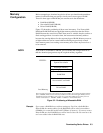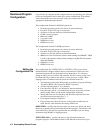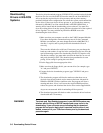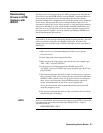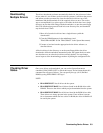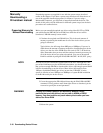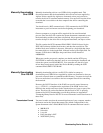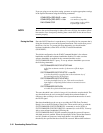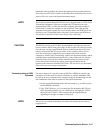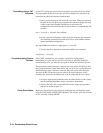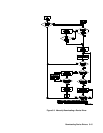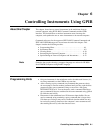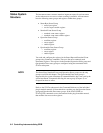Manually Downloading
Over GPIB
Manually downloading a driver over GPIB is fairly straightforward. This
discussion assumes that the downloadable device driver has been supplied by
Agilent. Drivers supplied by Agilent are formatted so that you just need to
transfer the driver to command module memory. You must also have the driver
on media that is accessible to the host computer that will be controlling the
download.
You should send a *RST command and a *CLS command to the SYSTEM
instrument to put it in a known state before beginning your download.
On most computers, a program will be required for the actual download
process. Since the driver file contains the System Instrument command to start
the downloading and the actual data to download, this program just needs to
transfer the bytes in the driver file to the System Instrument, one byte at a time.
This file contains the SCPI command DIAG:DRIV:LOAD followed by the
IEEE 488.2 arbitrary definite block header, and then the actual driver. The
definite block starts with the # character, followed by a single digit that shows
how many digits are in the length field, followed in turn by the length field. For
instance, a block that is 1000 bytes long would have a block header of
# 800001000.
When your transfer program is complete you should send the SCPI query
SYST:ERR? to make sure that there were no errors during the download, and
reboot the system (send DIAG:BOOT). You can make sure that all of your
drivers have been properly loaded into Driver RAM by sending the SCPI
command DIAG:DRIV:LIST:RAM?
Manually Downloading
Over RS-232
Manually downloading a driver over RS-232 is similar in concept to
downloading over GPIB. Drivers supplied by Agilent are formatted so that you
just need to transfer them to command module memory. You must also have the
driver on media that is accessible to the host computer that will be controlling
the download.
However, the RS-232 interface of the E1405 uses special control characters
(e.g., < CTRL-C> to implement the equivalent of the GPIB "device clear"
function) that would cause havoc in the download process if sent as part of the
driver. The driver file on the distribution disk that ends in "DC" is specially
formatted for RS-232 downloading to avoid this problem (see Appendix E
"Formatting Binary Data for RS-232" for more information on the data format of
these files).
Transmission Format You need to make sure that the transmission format of your computer matches
the format used at the System Instrument. The default configuration for the
System Instrument after a DIAG:BOOT:COLD command has been issued is
• 9600 BAUD
• 8 data bits
• 1 stop bit
• Parity checking is OFF
• XON/XOFF pacing
Downloading Device Drivers 5-11



